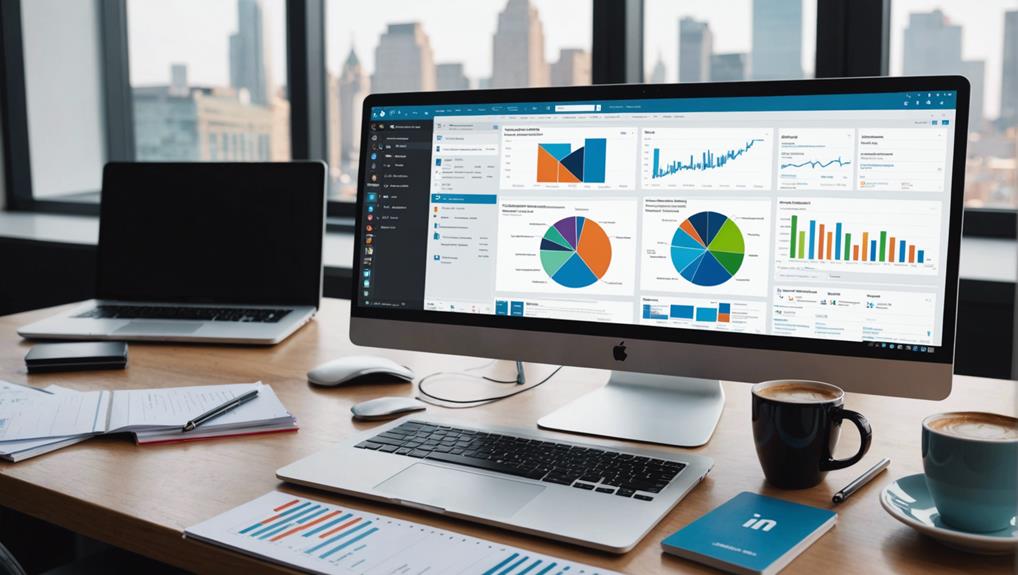Selecting top LinkedIn analytics tools is essential for harnessing detailed business insights and refining strategies. Tools like Sprout Social and Hootsuite offer thorough post performance analysis, while platforms such as Inlytics provide specialized LinkedIn data for optimized content strategies. SocialInsider and Keyhole deliver efficient competitor benchmarking and engagement tracking, supporting informed strategic choices. Evaluating these tools based on functionality, cost, and integration capabilities is critical for enhancing ROI and audience engagement. Utilizing these insights empowers businesses to tailor content and maintain a competitive edge in the digital landscape. Discover how these tools can boost your LinkedIn presence and strategy.
Key Takeaways
- Sprout Social provides comprehensive insights for LinkedIn content performance and audience engagement.
- SocialInsider offers advanced analytics for competitor benchmarking and strategic planning.
- Inlytics specializes in in-depth LinkedIn analytics for content optimization and audience understanding.
- Hootsuite delivers robust social media management features with cross-platform analytics.
- Keyhole enables hashtag tracking and competitive benchmarking for enhanced online presence.
Importance of LinkedIn Analytics
The importance of LinkedIn analytics cannot be overstated for businesses seeking to optimize their content strategies and enhance B2B lead generation efforts. As the leading platform for B2B engagement, LinkedIn’s analytics provide indispensable data-driven insights that empower businesses to refine their marketing strategies.
By diligently tracking key metrics such as engagement rates, impressions, and audience demographics, companies can tailor their content strategies to better align with audience preferences and expectations.
Audience insights derived from LinkedIn analytics are critical in understanding and segmenting the target market. These insights enable businesses to focus on content optimization, ensuring that every piece of content resonates with the intended audience and maximizes engagement rates.
By continuously analyzing performance metrics, businesses can make informed decisions, adjust their marketing strategies, and ultimately, track the effectiveness of their efforts over time.
Moreover, LinkedIn analytics serve as a compass for strategic focus, guiding companies to measure ROI and adapt to evolving trends in audience behavior.
Through a consistent analysis of these metrics, businesses can enhance their content strategy, ensuring sustained growth and improved B2B lead generation.
Fundamentally, leveraging LinkedIn analytics is paramount for businesses aiming to maintain a competitive edge in the digital landscape.
Choosing LinkedIn Analytics Tools
In selecting LinkedIn analytics tools, it is essential to prioritize features that align with your strategic objectives, such as engagement tracking and competitor analysis, ensuring they support your marketing goals.
Consider the balance between cost and functionality, evaluating whether native analytics suffice or if advanced third-party solutions are necessary for more thorough insights.
Additionally, assess the tools’ ability to integrate with other platforms to provide a unified view of your digital landscape, enhancing data-driven decision-making.
Tool Selection Criteria
Selecting the right LinkedIn analytics tools is vital for businesses aiming to optimize their social media strategy. Key performance metrics tracking is a fundamental aspect, enabling businesses to gain engagement insights and evaluate content effectiveness.
Tools that offer robust audience insights and competitor analysis can greatly impact strategic planning, allowing for more informed decisions. The ability to integrate with other social media management tools enhances the utility of LinkedIn analytics tools by providing a holistic view of digital performance across platforms.
Moreover, customizable reporting features are essential for aligning analytics with specific marketing goals. This capability allows businesses to tailor reports to their unique needs, guaranteeing that insights are directly applicable to strategy adjustments.
When evaluating tools, consider their integration capabilities, as seamless connections with existing systems can streamline workflows and enhance data accessibility.
Budget considerations are also critical, with pricing models ranging from free trials to monthly subscriptions and custom quotes. Selecting tools that align with both financial constraints and business objectives guarantees a strategic investment.
Ultimately, the right LinkedIn analytics tool should not only provide valuable insights but also support continuous improvement in social media management and overall business growth.
Essential Features Focus
Understanding the nuances of LinkedIn analytics tool selection lays the groundwork for identifying vital features that drive impactful social media strategies. LinkedIn analytics tools allow businesses to harness extensive metrics tracking, including shares, comments, and clicks, which are critical for evaluating engagement strategies and audience interaction.
Prioritizing tools that explore content performance and audience demographics will enable data-driven decisions, fundamental for tailoring content and optimizing your LinkedIn presence effectively.
The strategic selection of LinkedIn analytics tools should also focus on integration capabilities. This feature facilitates a holistic view of cross-channel performance, streamlining reporting processes and enhancing the ability to make informed adjustments in social media scheduling and content dissemination.
Additionally, tools that support LinkedIn ad performance tracking are indispensable, providing insights into return on investment and enabling businesses to refine marketing strategies based on real-time audience engagement data.
Ultimately, the choice of LinkedIn analytics tools should be driven by the need to support robust engagement strategies, optimize LinkedIn content, and provide actionable insights through data-driven decisions.
Budget and Integration
Choosing the right LinkedIn analytics tools is a strategic decision that requires careful consideration of both budget constraints and integration capabilities. Businesses must evaluate pricing models, which vary from affordable monthly subscriptions starting at $12 to tailored packages designed for specific needs. This financial aspect is vital in determining a tool’s viability within a company’s budget.
Equally important is analyzing the integration capabilities of these tools to guarantee seamless performance tracking across various social media platforms. This approach enhances your marketing strategy by providing extensive insights.
To maximize return on investment, prioritize tools offering robust features such as audience insights, engagement tracking, and content performance analysis. These features are fundamental for deriving actionable insights and optimizing marketing initiatives. Additionally, tools that facilitate LinkedIn advertising performance tracking are invaluable in measuring ROI and refining ad spend based on data-driven insights.
Exploring free trials, which typically span 14 to 30 days, provides an opportunity to evaluate the functionality and compatibility of these tools with your business’s unique analytics needs.
Essential Metrics to Track
To optimize LinkedIn marketing efforts, it is essential to focus on key engagement indicators such as shares, comments, and clicks, which provide a quantitative view of content resonance with the target audience.
Understanding audience demographics is equally important, as it allows businesses to strategically tailor their content and campaigns to specific segments, thereby enhancing overall effectiveness.
Together, these metrics form the foundation for a data-driven approach to refining content strategies and maximizing engagement on the platform.
Key Engagement Indicators
When leveraging LinkedIn for business growth, identifying key engagement indicators is essential for measuring content performance and audience interaction. Effective use of LinkedIn metrics, such as shares, comments, and clicks, can provide critical insights into how well your content resonates with your audience.
These indicators are foundational for understanding engagement rates, which are calculated by comparing the number of interactions to total impressions. This data-driven approach enables businesses to gauge content effectiveness and audience interest, offering a strategic focus on enhancing future LinkedIn efforts.
Audience demographics play a crucial role in tailoring content strategies, but impressions remain a significant metric. They reveal how often your posts are displayed, offering insights into your LinkedIn reach and visibility.
Audience Demographics Analysis
Understanding audience demographics is pivotal in crafting effective LinkedIn marketing strategies, as it allows businesses to precisely target their content to specific groups. By leveraging LinkedIn analytics, companies can meticulously track job titles, industries, and locations of profile visitors. Such insights enable strategic content targeting, ensuring that marketing efforts are aligned with the interests of distinct demographic segments.
Additionally, analyzing the seniority levels and company sizes of followers sheds light on potential decision-makers, allowing brands to refine their marketing strategies for greater impact. Monitoring engagement rates across various demographic segments provides valuable business insights into which audience groups resonate most with specific content.
This data-driven approach not only informs future campaigns but also helps in adapting strategies to accommodate evolving audience preferences. LinkedIn’s analytics tools offer the capability to observe shifts in follower demographics over time, facilitating performance benchmarking and market gap identification.
- Content targeting: Tailor marketing efforts by analyzing job titles, industries, and locations.
- Decision-makers identification: Refine strategies by understanding seniority levels and company sizes.
- Performance benchmarking: Use demographic insights to compare against competitors and optimize targeting.
These strategic insights are essential for businesses aiming to enhance their LinkedIn presence effectively.
Top Analytics Tools Overview
A multitude of advanced LinkedIn analytics tools are revolutionizing how businesses refine their social media strategies by offering in-depth insights and metrics. At the forefront, tools like Sprout Social and SocialInsider deliver thorough insights into post performance and engagement metrics.
These LinkedIn analytics tools empower businesses to tailor content strategies effectively by analyzing audience demographics, thereby enhancing their social media management efforts. The capabilities for performance tracking are essential for evaluating the impact of content and making data-driven decisions.
Inlytics excels in providing detailed analytics specifically for LinkedIn, allowing content creators to optimize posts based on audience insights and engagement trends.
Hootsuite stands out with its robust social media management features, enabling users to monitor engagement and follower growth across various platforms, including LinkedIn, from a single dashboard.
Keyhole offers specialized hashtag tracking and competitive benchmarking, which are significant for businesses aiming to monitor their online presence and refine LinkedIn strategies.
Tools like Buffer and Agorapulse enhance strategic focus with customizable reporting capabilities that automate performance tracking. These features are critical for marketing teams seeking to facilitate data-driven decision-making, ensuring that campaigns are not only effective but also aligned with organizational goals.
Social Media Management Benefits
Social media management tools have become indispensable assets for businesses aiming to maximize their LinkedIn presence. These platforms streamline the processes of content scheduling and publishing, ensuring a consistent and professional online presence.
By centralizing LinkedIn analytics, businesses can efficiently track performance and leverage detailed metrics to inform strategic decisions. This empowers marketing teams to monitor LinkedIn activities closely and adjust their strategies based on thorough analytics.
The benefits extend beyond operational efficiencies. Social media management platforms facilitate enhanced collaboration among marketing teams, improving communication and ensuring alignment on content strategies across various social media marketing channels.
Such tools provide insights to inform strategic decision-making, enabling businesses to optimize your content for increased audience engagement and effective lead generation.
The strategic use of these platforms translates into substantial benefits for brand visibility and presence on LinkedIn. By identifying and targeting specific audience segments, businesses can fine-tune their marketing efforts for maximum impact.
- Centralized Analytics: Simplifies tracking and strategy adjustments with thorough analytics.
- Enhanced Collaboration: Improves team communication and strategy alignment.
- Optimized Engagement: Uses insights to inform content optimization for better audience engagement.
Incorporating a social media management platform can therefore be a game-changer in achieving LinkedIn marketing success.
Exploring Free Trials and Pricing
Frequently, businesses are faced with the challenge of selecting the right LinkedIn analytics tools, where exploring free trials and pricing options can play an important role in the decision-making process. Many LinkedIn analytics tools provide free trials ranging from 14 to 30 days, offering an opportunity to explore key features and evaluate their compatibility with existing marketing strategies.
This period allows businesses to identify which metrics align best with their specific business needs and marketing goals.
Pricing models for LinkedIn analytics tools vary considerably. Basic plans start as low as $12 per month but typically offer limited analytics features. For enterprises requiring more extensive solutions, custom quotes may be available.
It is essential for businesses to assess these pricing models strategically, considering the long-term ROI. Selecting a tool that balances cost with the ability to deliver on marketing objectives is important.
Effectively utilizing free trials not only assists in testing functionalities but also in understanding the full scope of what each tool provides.
Competitor Analysis Strategies
In the domain of LinkedIn marketing, understanding competitor analysis strategies is pivotal for businesses aiming to refine their performance and capitalize on market opportunities.
Utilizing LinkedIn analytics tools such as SocialInsider and RivalIQ, companies can benchmark their LinkedIn performance against industry rivals, thereby identifying key strengths and weaknesses. By tracking performance through engagement metrics—likes, shares, and comments—businesses gain insights into effective content strategies that drive audience interaction.
Competitor analysis extends beyond mere numbers, as analyzing posting frequency and content types can uncover successful tactics. Historical data tracking further assists in evaluating competitors’ performance trends over time, revealing seasonal opportunities or shifts in audience preferences.
This strategic approach can guide your LinkedIn marketing strategy, allowing you to optimize content and enhance engagement with target audiences.
Leverage these insights to make informed adjustments to your marketing efforts:
- Benchmark against rivals: Use LinkedIn analytics tools to compare your metrics and understand market positioning.
- Identify successful tactics: Analyze competitors’ content strategies, learning from their engagement metrics.
- Adapt and optimize: Utilize historical data tracking to identify trends and shifts in audience preferences.
Implementing these strategies will enhance your LinkedIn marketing effectiveness.
Future Trends in LinkedIn Analytics
Building upon the insights gained from competitor analysis strategies, businesses can look forward to transformative changes in LinkedIn analytics with the advent of future trends. The integration of AI and machine learning technologies is set to revolutionize LinkedIn analytics, providing real-time insights and recommendations that enhance decision-making processes.
Businesses will increasingly focus on data-driven marketing strategies, utilizing detailed audience engagement metrics to boost community growth and content effectiveness. Future trends indicate a significant shift towards integrated analytics tools that offer a holistic view of performance across multiple social media platforms.
This approach enables brands to identify cross-channel engagement opportunities, strengthening their market presence. Enhanced competitor analysis features will further empower businesses to benchmark against industry rivals, revealing gaps and potential market opportunities.
As user privacy regulations continue to evolve, LinkedIn analytics tools must adapt to guarantee compliance while still delivering valuable insights into audience behavior and campaign effectiveness. This will necessitate innovative solutions that balance privacy with strategic data utilization.
Ultimately, these advancements will equip businesses with the necessary tools to maintain a competitive edge, fostering an environment where informed decisions drive success in the increasingly complex digital landscape.
Frequently Asked Questions
How Do Linkedin Analytics Tools Integrate With Other Marketing Platforms?
LinkedIn analytics tools seamlessly integrate with marketing platforms through robust API access, enhancing data visualization and CRM synergy. They optimize social media strategies, refine user experience, and deliver thorough campaign analysis via advanced reporting tools, performance metrics, and marketing automation.
Can Linkedin Analytics Tools Track Individual Employee Engagement?
LinkedIn analytics tools facilitate tracking of individual employee engagement by offering engagement metrics and audience demographics. These tools enhance employee performance understanding through content effectiveness, social listening, data visualization, trend analysis, and benchmarking strategies, ultimately aiding in ROI assessment and team collaboration.
What Challenges Might Users Face When Using Linkedin Analytics Tools?
Users may encounter data interpretation challenges, tool usability issues, and privacy concerns. Additionally, metric comprehension difficulties, integration compatibility problems, reporting accuracy concerns, feature overload issues, real-time data limitations, user training requirements, and data visualization challenges are prevalent.
How Often Should Businesses Review Linkedin Analytics Data?
Businesses should review LinkedIn analytics data weekly to optimize performance metrics, enhance audience insights, and refine content strategy. Regular analysis guarantees alignment with goals, tracks engagement trends, informs reporting schedules, and supports competitive analysis for actionable campaign effectiveness.
Are There Linkedin Analytics Tools Specifically for Small Businesses?
Yes, LinkedIn analytics tools tailored for small businesses provide small business benefits through analytics tool comparison, offering cost-effective solutions with user-friendly interfaces. These tools track engagement metrics, optimize growth strategies, offer content performance insights, and enable competitive analysis and ROI measurement.
Conclusion
LinkedIn analytics tools are indispensable for deriving business insights, enabling strategic decisions through extensive data analysis. Selecting the appropriate tools involves evaluating essential metrics and understanding the benefits of social media management. A thorough examination of available tools, including pricing and free trials, is vital for informed decision-making. Competitor analysis strategies further enhance competitive positioning. As future trends in LinkedIn analytics evolve, businesses must remain agile, continually adapting to maximize the platform’s potential for strategic advantage.




